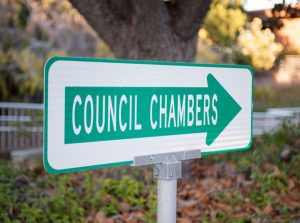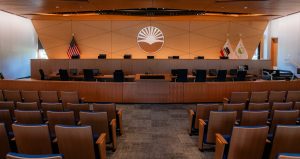Council Approves Climate Action Plan Add-On to 2010 General Plan
At the Dec. 3 meeting, the Santa Clara City Council unanimously approved a Climate Action Plan (CAP) as an addition to the city’s 2010 General Plan. There was considerable opinion on the part of the public and environmental groups that the plan should be more specific, aim for higher goals, and add a sustainability coordinator to the city staff.
All of this was duly noted by the Council, City Manager, and Planning Director for action as the city moves forward next year with a review of the General Plan and the 2014-2015 budget. In addition, with a new assistant city manager coming on board, City Manager Julio Fuentes committed to assigning the new hire to working with the Council on the CAP.
In 2006, the legislature enacted AB 32 requiring cities and counties to reduce greenhouse gas emissions to 1990 levels by 2020 – 15 percent below 2005 levels. That was followed in 2009 with SB 97 specifying what greenhouse gasses need to be addressed as part of the California Environmental Quality Act (CEQA): water vapor, carbon dioxide, methane, nitrous oxide, and ozone. Greenhouse gas emissions are measured in million metric tons of carbon dioxide equivalent (MT CO2e).
A municipal CAP supplies a roadmap for measuring and reducing greenhouse gas emissions. It identifies the sources, the reductions needed, and action and monitoring plans. Cities must have a CAP to be in compliance with state law. Without one, cities risk litigation and stalled development projects. On the benefit side, a city’s CAP can help reduce costs, by simplifying CEQA reviews and requiring fewer Environmental Impact Reports.
Santa Clara’s CAP reduces emissions by slightly more than 23 percent over 2008 levels – 532,900 fewer MT CO2es. Because Santa Clara owns its electric utility and generation plants, the city can exert influence over every aspect of the power usage chain – from replacing conventional power sources with renewable green generation, to promoting and investing in energy conservation.
“The plan is a great starting point,” said Council Member Teresa O’Neill. “A vast number of reductions are enabled because we own our electric utility.” But, she continued, “We need to add more teeth to the plan.” By comparison, Santa Clara’s nextdoor neighbor Sunnyvale has set itself a target of reducing emissions by 30 percent over 2008.
The biggest black mark on Santa Clara’s “green” report card is its part-ownership of the coal-fired San Juan generating station in New Mexico. The plant’s owners – including Silicon Valley Power – are making some short-term investments to reduce emissions with the long-term plan of replacing the coal-burning units with natural gas by 2017.
Other targets for emissions reduction included in the plan include:
- Growing SVP’s inventory of renewable energy sources.
- Programs to promote and reward energy efficiency throughout the city, and customer-installed solar units.
- Programs that specifically focus on reducing energy usage by the city’s large number of data centers (“server farms”) through energy audits and credits for energy-saving investments such as replacing air-conditioning with external air cooling.
- Water conservation – moving water throughout the city is a major energy sink
- Transportation and land use that reduces car trips.
- Reduce the city’s “urban heat island” effect with construction such as green roofs that reflect more sunlight and absorb less heat.
“Our staff has been proactive beyond belief on environmental issues,” said Council Member Pat Kolstad. “I remember when Council Member [Rod] Diridon, now City Clerk Diridon, suggested that we try to get half the vehicles in the city fleet to be low emission and zero-emission cars. I think the automotive fleet manager and the people in public safety took that as a challenge, because they vastly exceeded the goal that Council Member Diridon set. The utility director has made huge strides in getting renewable energy in this city.
“So regardless of whether we had a Climate Action Plan,” Kolstad concluded, “there’s nothing preventing staff from continuing to work in this direction in the future.”
New Developments Proposed to Breathe More Life Into Underused Parcels on Monroe and Winchester
It seems like there are so many new development projects being proposed in Santa Clara that it’s getting hard to keep track of them. One reason is that the public is getting an opportunity to take a look at these proposals earlier in the process, before Council action on zoning and permits is required.
Two interesting proposals that were reviewed by the Council in study sessions in November are Irvine’s Monticello Village project on 16 acres at 3515-3585 Monroe St. (near Lawrence Expressway), and MDM Investment Group’s proposal to convert an under-used medical office building at 100 N. Winchester Blvd. into a 60-unit residential building, Winchester Lofts.
Irvine’s Monticello Village proposes 825 residential units, 43,849 square feet of retail space, and 16,688 square feet of amenities; and includes all the parking needed for both uses rather than shared parking. The site currently is home to one-story industrial buildings with broad expanses of parking lots.
The developer is working with city staff to identify opportunities for amenities that can be offered to the community as a whole. The development will have retail downstairs and apartments upstairs, and the plan significantly improves street access in the area. Because of its close proximity to the CalTrain Lawrence Station, the development is particularly well oriented for public transit – and could, in fact, create the critical mass to transform a little-used train station.
“We’re particularly excited about this because of the place-making opportunity – retail, residential,” said Irvine’s spokesman, Darren Schulmeister. It provides the opportunity to “create very interesting places.” These are “spaces that people can feel protected, with a sense of place.” Further, he said, a diversity of architecture creates sense of being built up over time, and makes the development “an interesting place for years to come.” And yes, the possibly of bringing in a grocery store is being explored.
Another interesting transformation is being proposed by MDM Investment Group for an “underperforming” medical office building on 1.86 acres on N. Winchester between Pruneridge and Fernwood.
Built in the early 1970s on the site of former walnut packing plant, the three-story building is worth saving, said Santa Clara Planning Director Kevin Riley, because of its unique architectural and structural characteristics. Close to the Valley Fair transit hub, the re-purposing would “breath new life into a dying building,” said Riley, and promote a more transit-oriented lifestyle.
Requiescat in Pace
The Dec. 3 Council meeting was adjourned in memory of former city employee Michele Agnes Berritto, and former city legal counsel Clyde A. Thompson.











0 comments